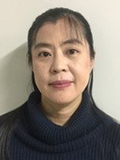RIKEN Nishina Center for Accelerator-Based Science Few-body Systems in Physics Laboratory
Director: Emiko Hiyama (D.Sc.)
Research Summary

In our laboratory, we are applying accurate few-body problem calculational method to various fields such as hypernuclear physics, unstable nuclear physics and hadron physics. As a result, we are getting new understanding by solving three- and four-body problem accurately. Especially, we are researching hypernuclear physics. The hypernucleus is composed of a hyperon, neutrons and protons. The research purpose in our laboratory is to understand interaction between hyperon and nucleon in unified way by studying the structure of the hypernuclei from the view points of three- and four-body problems. Recently, we have succeeded in developing our method up to five-body problem.
Main Research Fields
- Mathematical & Physical Sciences
Keywords
- Nuclear Physics
- Hadron
- Few-body problem
Selected Publications
Papers with an asterisk(*) are based on research conducted outside of RIKEN.
- 1.
D. Suenaga, K. Murakami, E. Itou, and K. Iida:
"Probing the hadron mass spectrum in dense two-color QCD with the linear sigma model"
Phys. Rev. D 107, 054001 (2023). - 2.
E. Hiyama, M. Isaka, T. Doi, and T. Hatsuda:
"Probing the ΞN interaction through inversion of spin-doublets in ΞNαα nuclei"
Phys. Rev. C 106, 064318 (2022). - 3.
D. Yoshida, Y. Kita, T. Shimazaki, and M. Tachikawa:
"A comprehensive theoretical study of positron binding and annihilation properties of hydrogen bonded binary molecular clusters"
Phys. Chem. Chem. Phys. 24, 26898 (2022). - 4.
Z. Yang, G.-J. Wang, J.-J. Wu, M. Oka, and S.-L. Zhu:
"Novel coupled channel framework connecting the quark model and lattice QCD for the near-threshold Ds states"
Phys. Rev. Lett. 128, 112001 (2022). - 5.
Q. Meng, M. Harada, E. Hiyama, A. Hosaka, and M. Oka:
"Doubly heavy tetraquark resonant states"
Phys. Lett. B 824, 136800 (2021). - 6.
*L. Happ, M. Zimmermann, S.I. Betelu, W.P. Schleich, and M.A. Efremov:
"Universality in a one-dimensional three-body system"
Phys. Rev. A. 100, 012709 (2019). - 7.
P. Naidon and S. Endo:
"Efimov Physics: a review"
Rep. Prog. Phys. 80, 056001 (2017). - 8.
P. Naidon, S. Endo, and M. Ueda:
"Microscopic Origin and Universality Classes of the Efimov Three-Body Parameter"
Phys. Rev. Lett. 112, 105301 (2014). - 9.
E. Hiyama:
"Gaussian expansion method for few-body systems and its applications to atomic and nuclear physics"
Prog. Theor. Exp. Phys. 2012, 01A204 (2012). - 10.
E. Hiyama:
"Few-Body Aspects of Hypernuclear Physics"
Few-Body Syst. 53, 189 (2012).
Related Links
Lab Members
Principal investigator
- Emiko Hiyama
- Director
Core members
- Pascal Naidon
- Senior Research Scientist
- Makoto Oka
- Senior Visiting Scientist
- Nodoka Yamanaka
- Contract Researcher
- Lucas Happ
- Special Postdoctoral Researcher
- Ahmad Jafar Arifi
- Special Postdoctoral Researcher
- Shuhei Ohno
- Junior Research Associate
- Jinniu Hu
- Visiting Scientist
- Ying Zhang
- Visiting Scientist
Contact Information
2-1 Hirosawa,
Wako, Saitama
351-0198, Japan
Email: hiyama [at] riken.jp
